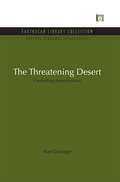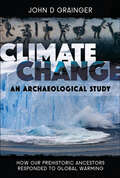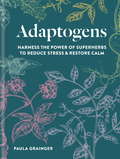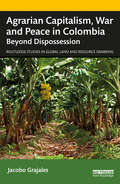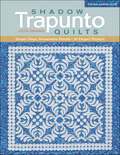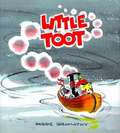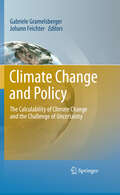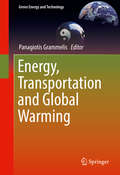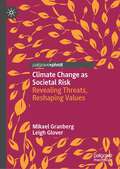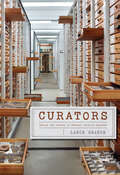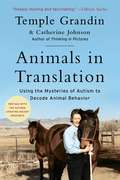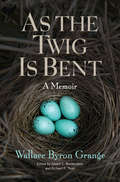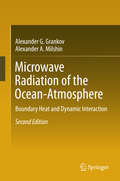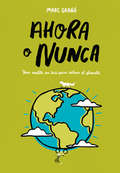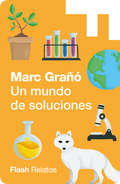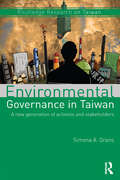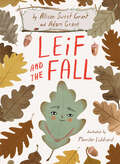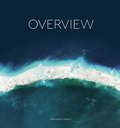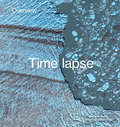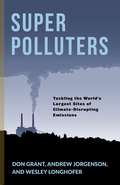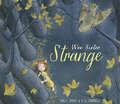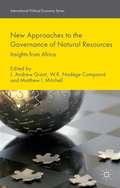- Table View
- List View
The Threatening Desert: Controlling desertification (Natural Resource Management Set #3)
by Alan GraingerLands lost to desert may effectively be lost for ever, so desertification is humanity's most obvious despoliation to the planet. It is certainly one of the most serious environmental problems facing the world today. In this book the author describes what is happening and where. Although the problem is greatest in developing countries, it is by no means confined to them. Australia, Africa, the USA and India are all affected. In the 1970s an international Plan of Action was drawn up to bring the phenomenon under control, but it was never implemented. Now that the situation is more serious than ever before, this book urges new action and describes many of the myriad ways in which it is possible to arrest the progress of desertification. It describes, too, not just the failures, but the considerable successes that have been achieved. Originally published in 1990
Climate Change: How Our Prehistoric Ancestors Responded to Global Warming
by John D. GraingerHow prehistoric humans coped with the end of the last Ice Age—and catastrophic global warming.Global warming is among the most urgent problems facing the world today. Yet many commentators, and even some scientists, discuss it with reference only to the changing climate of the last century or so. John Grainger takes a longer view and draws on the archaeological evidence to show how our ancestors faced up to the ending of the last Ice Age, arguably a more dramatic climate change crisis than the present one. Ranging from the Paleolithic down to the development of agriculture in the Neolithic, the author shows how human ingenuity and resourcefulness allowed them to adapt to the changing conditions in a variety of ways as the ice sheets retreated and water levels rose. Different strategies, from big game hunting on the ice, nomadic hunter gathering, sedentary foraging, and finally farming, were developed in various regions in response to local conditions as early man colonized the changing world. The human response to climate change was not to try to stop it, but to embrace technology and innovation to cope with it.
Climate Change: How Our Prehistoric Ancestors Responded to Global Warming
by John D. GraingerHow prehistoric humans coped with the end of the last Ice Age—and catastrophic global warming.Global warming is among the most urgent problems facing the world today. Yet many commentators, and even some scientists, discuss it with reference only to the changing climate of the last century or so. John Grainger takes a longer view and draws on the archaeological evidence to show how our ancestors faced up to the ending of the last Ice Age, arguably a more dramatic climate change crisis than the present one. Ranging from the Paleolithic down to the development of agriculture in the Neolithic, the author shows how human ingenuity and resourcefulness allowed them to adapt to the changing conditions in a variety of ways as the ice sheets retreated and water levels rose. Different strategies, from big game hunting on the ice, nomadic hunter gathering, sedentary foraging, and finally farming, were developed in various regions in response to local conditions as early man colonized the changing world. The human response to climate change was not to try to stop it, but to embrace technology and innovation to cope with it.
Adaptogens: Harness the power of superherbs to reduce stress & restore calm
by Paula GraingerIncreasing numbers of people are suffering from stress, anxiety and fatigue caused by lack of sleep, digital overload and our 24/7 lifestyle. In Adaptogens, Medical Herbalist Paula Grainger provides an answer to this modern-day affliction by introducing us to the group of powerful herbal ingredients known as adaptogens..Adaptogens, such as Ashwagandha, Maca, Korean ginseng, Turmeric, Reishi mushrooms, Liquorice, Rosemary and Rhodiola, have been scientifically proven to lower levels of the stress hormone cortisol and prevent adrenal imbalances that can lead to adrenal fatigue and 'burn-out'. Delve into the history and science of these miraculous plants and learn how to maximize wellness using the most easy-to-source adaptogens, incorporating them into your life via delicious smoothies, energy bites and desserts, invigorating teas, tonics and lattes, and wonderful beauty elixirs.
Adaptogens: Harness the power of superherbs to reduce stress & restore calm
by Paula GraingerIncreasing numbers of people are suffering from stress, anxiety and fatigue caused by lack of sleep, digital overload and our 24/7 lifestyle. In Adaptogens, Medical Herbalist Paula Grainger provides an answer to this modern-day affliction by introducing us to the group of powerful herbal ingredients known as adaptogens..Adaptogens, such as Ashwagandha, Maca, Korean ginseng, Turmeric, Reishi mushrooms, Liquorice, Rosemary and Rhodiola, have been scientifically proven to lower levels of the stress hormone cortisol and prevent adrenal imbalances that can lead to adrenal fatigue and 'burn-out'. Delve into the history and science of these miraculous plants and learn how to maximize wellness using the most easy-to-source adaptogens, incorporating them into your life via delicious smoothies, energy bites and desserts, invigorating teas, tonics and lattes, and wonderful beauty elixirs.
Agrarian Capitalism, War and Peace in Colombia: Beyond Dispossession (Routledge Studies in Global Land and Resource Grabbing)
by Jacobo GrajalesBased on extensive research conducted in Colombia since 2009, this book addresses the connection between land grabbing and agrarian capitalism, as well as the unfulfilled promises of peace and justice. While land remains a key resource at the core of many contemporary civil wars, the impact of high-intensity armed violence on the formation of agrarian capitalism is seldom discussed. Drawing on nearly 200 interviews, archival research, and geographical data, this book examines land grabbing and the role of violence in capital with a particular focus on one key actor in the Colombian civil war: paramilitary militias. This book demonstrates how the intricate ties between armed conflict and economy formation are obscured by the widespread belief that violence is a radical form of action, breaking with the normal course of society and disconnected from the legal economy. Under this view, dispossession is perceived as diametrically opposed to capitalist accumulation. This belief is enormously influential in precisely those bureaucratic agencies that are in charge of peacebuilding, both domestically and internationally. However, this narrow view of the relationship between armed violence and capitalism belies the close ties between plunder and lawful profit, and obscures the continuity between violent dispossession and the free market. By the same token, it legitimizes post-war inequality in the name of capitalist development. The book concludes by arguing that the promotion of radical democracy in the government of land and rural development emerges as the only reasonable path for pacifying a violent polity. The book is essential reading for students, scholars, and development aid practitioners interested in land and resource grabbing, agrarian capitalism, civil wars, and conflict resolution.
Shadow Trapunto Quilts: Simple Steps, Remarkable Results, 30 Elegant Projects
by Geta GramaA wonderful world of intricate beauty You'll be captivated by the elegance and grace of these elaborate shadow trapunto quilts-especially once you discover how easy they are to make! Create the old-world look of tatting or lace with a simple 3-step technique. Geta provides instructions and patterns for working with whole cloth, pieced, or appliqué backgrounds. A gorgeous gallery of her work is included. • 30 remarkable projects include wallhangings, pillows, tablerunners, and postcards • Achieve old-world style with this innovative technique • Patterns in the book can be enlarged; full-size patterns are on the enclosed CD
Little Toot
by Hardie GramatkyIn this Weekly Reader Children's Book Club selection, a tiny tug rescues a big ship.
Climate Change and Policy: The Calculability of Climate Change and the Challenge of Uncertainty
by Gabriele Gramelsberger Johann FeichterThe debate on how mankind should respond to climate change is diverse, as the appropriate strategy depends on global as well as local circumstances. As scientists are denied the possibility of conducting experiments with the real climate, only climate models can give insights into man-induced climate change, by experimenting with digital climates under varying conditions and by extrapolating past and future states into the future. But the 'nature' of models is a purely representational one. A model is good if it is believed to represent the relevant processes of a natural system well. However, a model and its results, in particular in the case of climate models which interconnect countless hypotheses, is only to some extent testable, although an advanced infrastructure of evaluation strategies has been developed involving strategies of model intercomparison, ensemble prognoses, uncertainty metrics on the system and component levels. The complexity of climate models goes hand in hand with uncertainties, but uncertainty is in conflict with socio-political expectations. However, certain predictions belong to the realm of desires and ideals rather than to applied science. Today's attempt to define and classify uncertainty in terms of likelihood and confidence reflect this awareness of uncertainty as an integral part of human knowledge, in particular on knowledge about possible future developments. The contributions in this book give a first hand insight into scientific strategies in dealing with uncertainty by using simulation models and into social, political and economical requirements in future projections on climate change. Do these strategies and requirements meet each other or fail? The debate on how mankind should respond to climate change is diverse, as the appropriate strategy depends on global as well as local circumstances. As scientists are denied the possibility of conducting experiments with the real climate, only climate models can give insights into man-induced climate change, by experimenting with digital climates under varying conditions and by extrapolating past and future states into the future. But the 'nature' of models is a purely representational one. A model is good if it is believed to represent the relevant processes of a natural system well. However, a model and its results, in particular in the case of climate models which interconnect countless hypotheses, is only to some extent testable, although an advanced infrastructure of evaluation strategies has been developed involving strategies of model intercomparison, ensemble prognoses, uncertainty metrics on the system and component levels. The complexity of climate models goes hand in hand with uncertainties, but uncertainty is in conflict with socio-political expectations. However, certain predictions belong to the realm of desires and ideals rather than to applied science. Today's attempt to define and classify uncertainty in terms of likelihood and confidence reflect this awareness of uncertainty as an integral part of human knowledge, in particular on knowledge about possible future developments. The contributions in this book give a first hand insight into scientific strategies in dealing with uncertainty by using simulation models and into social, political and economical requirements in future projections on climate change. Do these strategies and requirements meet each other or fail? Gabriele Gramelsberger is Principal Investigator of the Collaborative Research Project is Principal Investigator of the Collaborative Research Project
Energy, Transportation and Global Warming
by Panagiotis GrammelisThis book presents a holistic view of climate change by examining a number of energy and transportation technologies and their impact on the climate. High-quality technical research results from specific test-cases around the globe are presented, and developments in global warming are discussed, focusing on current emissions policies from air and maritime transport to fossil fuel applications. Novel technologies such as carbon capture and storage are investigated together with the corresponding process and systems analysis, as well as optimization for mitigating CO2 emissions. Water resources management, waste water treatment, and waste management issues are also covered. Finally, biomass, hydrogen and solar energy applications are presented along with some insights on green buildings. Energy, Transportation and Global Warming is of great interest to researchers in the field of renewable and green energy as well as professionals in climate change management, the transportation sector, and environmental policy.
Climate Change as Societal Risk: Revealing Threats, Reshaping Values
by Mikael Granberg Leigh GloverThis book analyzes climate change from a societal risk perspective, considering IPCC data, harm reduction, and global impact. Climate change is a globalised agent of social disruption whose impacts will worsen societal inequities and inequalities around the world. For some unfortunate societies already precariously exposed, climate change will tip them into societal collapse. Devastation will also occur to many ecological values in which all societies are embedded. But effective social action can limit the extent of these costs and losses. Ultimately, only social transformation can limit the social and environmental harms of climate change. But what does this mean? To what extent is society at risk? Are such risks particularized and restricted to specific segments and localities? Or is society at risk in a more universal way? Climate risks are re-shaping the practices of households, communities, governments and businesses. In this way, climate risks are a dynamic element in social change and social processes. Risk holds a mirror to society, revealing who and what is prioritized, recognized and valued. It also provides a reckoning of our perceived strengths, vulnerabilities and weaknesses. This volume examines how we understand the societal risks of contemporary and forecast climate change impacts—and those risks inherent in dealing with these impacts. We know that society is fashioning a new global climate—but climate change is also re-fashioning society; this book explores this dynamic process and considers its implications for future society.
Curators: Behind the Scenes of Natural History Museums
by Lance GrandeOver the centuries, natural history museums have evolved from being little more than musty repositories of stuffed animals and pinned bugs, to being crucial generators of new scientific knowledge. They have also become vibrant educational centers, full of engaging exhibits that share those discoveries with students and an enthusiastic general public. At the heart of it all from the very start have been curators. Yet after three decades as a natural history curator, Lance Grande found that he still had to explain to people what he does. This book is the answer—and, oh, what an answer it is: lively, exciting, up-to-date, it offers a portrait of curators and their research like none we’ve seen, one that conveys the intellectual excitement and the educational and social value of curation. Grande uses the personal story of his own career—most of it spent at Chicago’s storied Field Museum—to structure his account as he explores the value of research and collections, the importance of public engagement, changing ecological and ethical considerations, and the impact of rapidly improving technology. Throughout, we are guided by Grande’s keen sense of mission, of a job where the why is always as important as the what. This beautifully written and richly illustrated book is a clear-eyed but loving account of natural history museums, their curators, and their ever-expanding roles in the twenty-first century.
Animals in Translation: Using the Mysteries of Autism to Decode Animal Behavior (Read-On)
by Temple Grandin Catherine JohnsonWith unique personal insight, experience, and hard science, Animals in Translation is the definitive, groundbreaking work on animal behavior and psychology.Temple Grandin&’s professional training as an animal scientist and her history as a person with autism have given her a perspective like that of no other expert in the field of animal science. Grandin and coauthor Catherine Johnson present their powerful theory that autistic people can often think the way animals think—putting autistic people in the perfect position to translate &“animal talk.&” Exploring animal pain, fear, aggression, love, friendship, communication, learning, and even animal genius, Grandin is a faithful guide into their world. Animals in Translation reveals that animals are much smarter than anyone ever imagined, and Grandin, standing at the intersection of autism and animals, offers unparalleled observations and extraordinary ideas about both.
Aquatic Mesocosm Studies in Ecological Risk Assessment
by Robert L. GraneyA Special Publication of the Society of Environmental Toxicology and Chemistry (SETAC)Aquatic Mesocosm Studies in Ecological Risk Assessment discusses the methods currently used for conducting simulated field studies and provides a series of case histories in which mesocosm type studies have been used to assess the impact of pesticides on aquatic ecosystems. Specific chapters address the dosing and exposure components of such studies and how they influence experimental design. Advantages and disadvantages of various statistical designs are addressed in detail. Regulatory aspects of the design and interpretation of these studies are also covered. The book will be a superb reference for aquatic biologists, ecologists, toxicologists, environmental toxicologists, environmental chemists, and regulatory personnel.
As the Twig Is Bent: A Memoir
by Wallace Byron GrangeWallace Byron Grange (1905–87) was an influential conservationist who worked alongside Aldo Leopold. Grange’s story vividly describes his mostly idyllic childhood watching bird life in the once grand prairies just west of Chicago. He documents his family’s journey and pioneering struggle to operate a farm on the logged cutover country in northern Wisconsin, a land that provided him with abundant opportunities to study the lives of wild creatures he loved most. Written when Grange was in his sixties, As the Twig Is Bent conveys how a leading conservationist was formed through his early relationship to nature. In beautifully composed vignettes, he details encounters both profound and minute, from the white-footed mice attracted by cookie crumbs in his boyhood clubhouse to the sounds of great horned owls echoing through the wintry woods. As he develops his own understanding of the natural world, he comes to an awareness of the dramatic and devastating role of humankind on ecosystems. Grange’s poignant observations still resonate today amid global conversations about the fate of our natural resources and climate change.
Microwave Radiation of the Ocean-Atmosphere
by Alexander G. Grankov Alexander A. MilshinThe book describes different approaches to the analysis of heat and dynamic processes in the ocean-atmospheric interface with satellite passive radiometric observations at microwaves. It examines the feasibility of determining synoptic, seasonal and year-to-year variations of sensible, latent and momentum fluxes to a useful accuracy using the DMSP SSM/I and EOS Aqua AMSR-E data directly from the measured brightness temperatures. An important object in the studies is the North Atlantic with emphasize on the areas with high midlatitude cyclon activity: here the main results have been obtained by combining data from the vessel experiments NEWFOUEX-88, ATLANTEX-90 and the data of microwave radiometers from the DMSP and EOS Aqua satellites. The role of vertical turbulent and horizontal advective heat transfer in forming interrelations between the brightness temperature of the system ocean-atmosphere and surface heat fluxes in the range of synoptic time scales is analyzed. Special sections of the book describe some results of analysis of reaction of the system ocean-atmosphere on passing of the tropical cyclone Katrina (August 2005) in the Florida Strait as well as a behavior of the system in the period of a time preceding to origination the cyclone Humberto (September 2007) in the Mexico Gulf. The long-term goal of this research is the search for effects and regularities, which can explain the reasons for the tropical cyclones appearance. Some characteristics of the tropical cyclones (brightness temperature and heat contrasts, etc. ) are compared with those for midlatitude cyclones. At the same time as covering a key topic area with implications for global warming research, this text is also usefull to students who want to gain insight into application of satellite microwave radiometric methods for studying the air-sea interaction. Key themes: microwave radiometry, air-sea interaction, midlatitude and tropical cyclones, atmosphere boundary layer, heat and momentum surface fluxes.
Ahora o nunca: Una vuelta en bici para salvar el planeta
by Marc GrañóHace diez años, todavía había quien dudaba del cambio climático, las abejas no estaban en peligro de extinción, y reciclar era opcional. Hoy, todo esto es nuestra realidad. #AhoraoNuncaLibro <P><P>Vivimos en un mundo en el que: <br>1.- los grandes bosques... están siendo talados. <br>2.- muchas especies de animales... desaparecen cada año. <br>3.- los veranos son más largos y calurosos..., y los inviernos más cortos y menos fríos. <P>Ahora o nunca nos da una vuelta al mundo para ver la realidad de la Tierra con los ojos abiertos. Aprenderás qué puedes hacer tú, día a día, paso a paso, para salvar el planeta.
Un mundo de soluciones
by Marc GrañóHay un mundo de soluciones para frenar el cambio climático. Después de haber viajado por el mundo y ver la consecuencias del cambio climático, un zorro del ártico descubrirá algunas de las soluciones que tienen los humanos para reducir las emisiones de dióxido de carbono y, por lo tanto, salvar el planeta. Con la ayuda de una doctora muy especial, el zorro aprenderá que hay muchas herramientas para que entre todos frenemos el cambio climático. Este relato, que forma parte del libro Ahora o nunca de Marc Grañó, presenta de manera muy didáctica y positiva algunas de las posibles soluciones para ayudar al planeta entre todos.
Environmental Governance in Taiwan: A New Generation of Activists and Stakeholders (Routledge Research on Taiwan Series)
by Simona A. GranoThree decades of rapid industrialization until the lifting of martial law in 1987, with little or no concern for the environment, have made Taiwan’s environmental degradation a serious problem. In the past twenty years, Taiwan has seen a surge of environmental organizations, which to a certain degree have enjoyed a remarkable success in fighting polluting industries or affecting policies on behalf of the environment. This book aims to analyse environmental governance mechanisms and actors in Taiwan through a multi-disciplinary research approach. Based on extensive and original research, it includes four different case studies, which have all taken place since 2011. It focuses on four major elements of governance - specifically norms, actors, processes, and outcomes - to examine Taiwan’s national and local environmental governance in the post-2008 period. The book shows how the painful lessons Taiwan has learned throughout its transition should be of interest to other developing countries, illustrating how these positive transformations have managed to bring about a more ecologically friendly mode of economic development. Demonstrating that the battle to further ecological sustainability is also a battle to further democratisation, this book will be of interest to students and scholars of Taiwan Studies, Developmental Studies and Environmental Studies.
Leif and the Fall
by Allison Sweet Grant Adam GrantPersistence and creativity can lead to amazing things, as Leif the leaf discovers in this lovely storybook from Allison Sweet Grant and Adam Grant, the #1 New York Times bestselling author of Originals.Leif is a leaf. A worried leaf. It is autumn, and Leif is afraid to fall. "All leaves fall in the fall," say the other leaves. But Leif is determined to find a different way down, and with his friend Laurel, he uses the resources around him to create a net, a kite, a parachute in hopes of softening his landing. The clock is ticking, the wind is blowing. What will happen when a gust of wind pulls Leif from his branch?In a culture that prizes achievement, kids are often afraid to fail--failing to realize that some of the very ideas that don't work are steps along the path to ones that will.
Overview: A New Perspective of Earth
by Benjamin GrantA stunning and unique collection of satellite images of Earth that offer an unexpected look at humanity, derived from the wildly popular Daily Overview Instagram project.Inspired by the "Overview Effect"--a sensation that astronauts experience when given the opportunity to look down and view the Earth as a whole--the breathtaking, high definition satellite photographs in OVERVIEW offer a new way to look at the landscape that we have shaped. More than 200 images of industry, agriculture, architecture, and nature highlight incredible patterns while also revealing a deeper story about human impact. This extraordinary photographic journey around our planet captures the sense of wonder gained from a new, aerial vantage point and creates a perspective of Earth as it has never been seen before.From the Hardcover edition.
Overview Timelapse: How We Change the Earth
by Benjamin Grant Timothy DoughertyA stunning and unique collection of satellite images of Earth that offer an unexpected look at humanity, derived from the wildly popular Daily Overview Instagram project.Inspired by the &“Overview Effect&”—a sensation that astronauts experience when given the opportunity to look down and view the Earth as a whole—the breathtaking, high definition satellite photographs in OVERVIEW offer a new way to look at the landscape that we have shaped. More than 200 images of industry, agriculture, architecture, and nature highlight incredible patterns while also revealing a deeper story about human impact. This extraordinary photographic journey around our planet captures the sense of wonder gained from a new, aerial vantage point and creates a perspective of Earth as it has never been seen before.
Super Polluters: Tackling the World’s Largest Sites of Climate-Disrupting Emissions (Society and the Environment)
by Don Grant Andrew Jorgenson Wesley LonghoferPower plants are essential to achieving the standard of living that modern societies demand and the social and economic infrastructure on which they depend. Yet their indispensability has allowed them to evade responsibility for their vast carbon emissions. Fossil-fueled power plants are the single largest sites of anthropogenic greenhouse gases, making them one of the greatest threats to our planet’s climate. Significant as they are, we lack a comprehensive understanding of the social causes that enable power plant emissions and continue to delay their reduction.Super Polluters offers a groundbreaking global analysis of carbon pollution caused by the generation of electricity, pinpointing who bears the most responsibility for the energy sector’s vast emissions and what can be done about them. The sociologists Don Grant, Andrew Jorgenson, and Wesley Longhofer analyze a novel dataset on the carbon dioxide emissions and structural attributes of thousands of fossil-fueled power plants around the world, identifying which plants discharge the most carbon. They investigate the global, organizational, and political conditions that explain these hyper-emitting facilities’ behavior and call into question the claim that improvements in technical efficiency will always reduce emissions. Grant, Jorgenson, and Longhofer demonstrate which energy and climate policies are most effective at abating power-plant pollution, emphasizing how mobilized citizen activism shapes those outcomes. A comprehensive account of who bears the blame for our warming planet, Super Polluters points to more feasible and effective emission reduction strategies that target the world’s most profligate polluters.
Wee Sister Strange
by Holly Grant K. G. CampbellWith a lyrical text and gorgeous, ethereal illustrations, here is a mesmerizing and magical original bedtime fairy tale reminiscent of Emily Winfield Martin&’s Dream Animals, and perfect for reading aloud. They say there's a girl Who lives by the woods In a crooked old house With no garden but gloom. She doesn't have parents. No one knows her name. But the people in town Call her Wee Sister Strange. Like Emily Winfield Martin&’s bestselling Dream Animals, here is a bedtime read-aloud sure to entrance young listeners. Each evening, as the shadows grow long, Wee Sister Strange climbs from her window and runs into the woods. She talks to the owls and rides on a bear. She clambers up trees and dives into the bog. She is searching for something.... She looks far and wide, over forest and marsh. What is it she seeks? Why, it's a wee bedtime story to help her fall asleep!
New Approaches to the Governance of Natural Resources
by J. Andrew Grant W.R. Nad�ge Compaor� Matthew I. MitchellThe resurgent economic and geopolitical importance of Africa is evidenced by the growing investment by China, India, the United States, Brazil, and other countries in the continent's various natural resources sectors, such as oil, biofuels, forestry, fisheries, and minerals. This book provides an in-depth analysis of the governance of natural resources in Africa and new insights for readers as they navigate the burgeoning research on global governance initiatives and regional and national strategies. Moreover, by carefully examining both theoretical and policy-related debates (and drawing upon public opinion data in countries such as Angola and South Sudan), the book makes important connections between theory and practice surrounding natural resource sectors. Consequently, it offers scholars, graduate students, policy-makers, think tank researchers, and media with a comprehensive and authoritative examination of the current research being conducted on the governance of natural resources in Africa.
